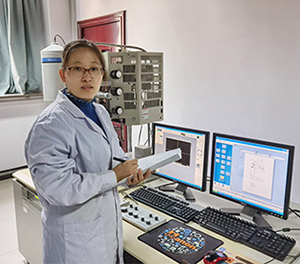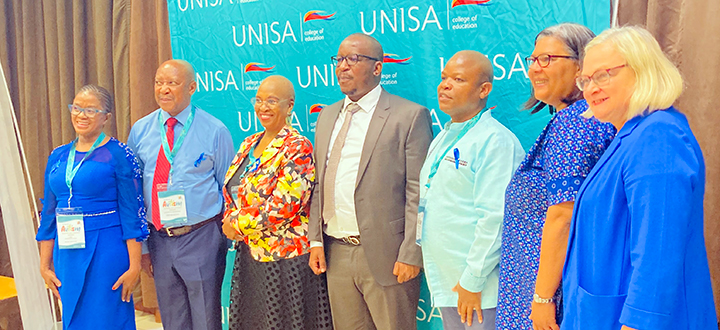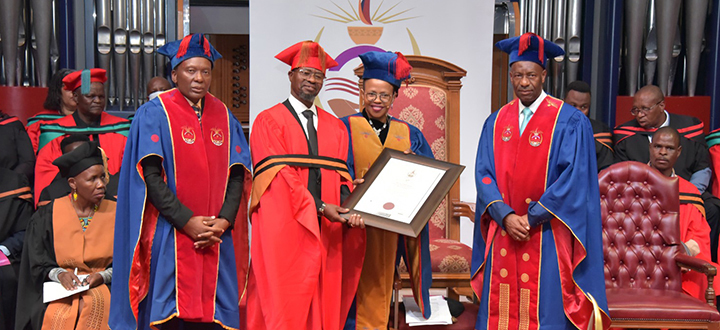College of Science, Engineering & Technology
Meet the first graduate of China-SA lab initiative on new energy

Shuang Zong
High energy consumption, pollution and non-renewable fossil fuels are not conducive to the sustainable development of human society. "Clean, high-capacity and renewable energy storage and conversion techniques are promising alternatives to traditional fossil fuels," says Shuang Zong, the first person to graduate from the International Research Laboratory of New Energy.
This laboratory, housed at the Hebei University of Science and Technology (HEBUST) in the People’s Republic of China, is a joint initiative of HEBUST and the Institute for the Development of Energy for African Sustainability (IDEAS) at Unisa.
This initiative was established with funding from Hebei province in China and HEBUST under the leadership of two Unisa scholars, Prof Diane Hildebrandt and Prof Xinying Liu of IDEAS. The mandate of the collaboration is to conduct research in the field of biomass utilisation, green chemistry and green hydrogen production.
"I am very honoured to have had an opportunity to study with excellent professors such as Prof Liu, Prof Hildebrandt, Prof Aibing Chen and Prof Yali Yao. Their guidance has enabled me to progress with my research studies," says Zong, adding that it is even more of a privilege to be the first student to graduate from this programme.
A citizen of the People’s Republic of China, where she is based, Zong visited Unisa’s Science Campus before the outbreak of the Covid-pandemic and is familiar with the excellent facilities available in South Africa.
Graduating with distinction
Zong, who received her MTech in Chemical Engineering with distinction through the International Research Laboratory for New Energy, has also registered for her PhD under the joint research collaboration.
"I am working hard on my PhD degree in electrochemical oxygen reduction reaction (ORR), oxygen evolution reaction (OER) and hydrogen evolution reaction (HER) of porous carbon materials," she says.
These reactions are at the heart of the renewable energy storage and conversion technologies that are increasingly being seen as alternatives to fossil fuels.
Zong says a paramount aspect is the development of low-cost, highly active and robust catalysts based on earth-abundant, non-noble metals for these important electrocatalytic processes. In this regard, porous carbon materials – which are her main research focus – have become a research hotspot. "We firmly believe that our research will provide new insights into preparation strategies of porous carbon materials and theoretical guidance on structure-performance relationships," she says.
"I am expecting our current research results to provide new ideas for the development of carbon materials for researchers in the energy storage industry, and also hope for our strategies for carbon materials synthesis to be widely used in material design in the field of catalysis, adsorption, separation, batteries and other related fields."
Research has been Zong’s passion since 2007, when she completed her BEng studies at HEBUST in the field of pharmaceutical engineering, a branch of chemical engineering. She then worked in research labs at pharmaceutical manufacturing companies as a technician and engineer. As a lover of scientific research and after 10 years of working, Zong decided to pursue a full-time research qualification in chemical and material engineering.
Six papers already published and more to come
She has grown into a highly published researcher with a solid publishing record.
While studying towards her MTech between 2018 and 2020, Zong published six papers; four of them are in Q1 journals and one in a Q2 journal (see the table for details of the journals concerned).
Zong is currently busy writing more papers from her MTech research study and has at least two more ready for journal publication submission.
Items |
Publications |
Journals |
Citations |
| 1 | PVP-assisted preparation of nitrogen-doped mesoporous carbon materials for supercapacitors |
Journal of Materials Science and Technology, 2020, 58, 197-204. (Q1) |
6 |
| 2 | Co-assembly strategy for uniform and tunable hollow carbon spheres with supercapacitor application |
Journal of Colloid and Interface Science, 2020, 565, 245-253. (Q1) |
11 |
| 3 | N-doped porous carbon nanotubes derived from polypyrole for supercapacitors with high performance |
Journal of Analytical and Applied Pyrolysis, 2020, 152, 104925. (Q1) |
1 |
| 4 | Preparation of hollow mesoporous carbon spheres by pyrolysis deposition using surfactant as carbon precursor |
Journal of Power Sources, 2021, 484, 229274. (Q1) |
0 |
| 5 | Porous yolk-shell structured carbon nanospheres for electrochemical energy storage |
Journal of Materials Science: Materials in Electronics, 2020, doi: 10.1007/s10854-020-03885-8 (Q2) |
0 |
| 6 | Metal-organic framework derived 0 dimensional materials for supercapacitors | CIESC Journal, 2020, 71(6), 2612-2627. | 0 |
* Written by Mpho Moloele, Research Support Directorate
Publish date: 2021-10-19 00:00:00.0

 Young Unisa doctoral graduate joins elite Lindau Nobel Laureate group
Young Unisa doctoral graduate joins elite Lindau Nobel Laureate group
 Education MEC addresses Unisa autism seminar
Education MEC addresses Unisa autism seminar
 Seven Unisans nominated for the NSTF-South32 Awards 2023/2024
Seven Unisans nominated for the NSTF-South32 Awards 2023/2024
 Unisa awards posthumous honorary doctorate to literary maven, OK Matsepe
Unisa awards posthumous honorary doctorate to literary maven, OK Matsepe
 From humble beginnings to academic leadership
From humble beginnings to academic leadership